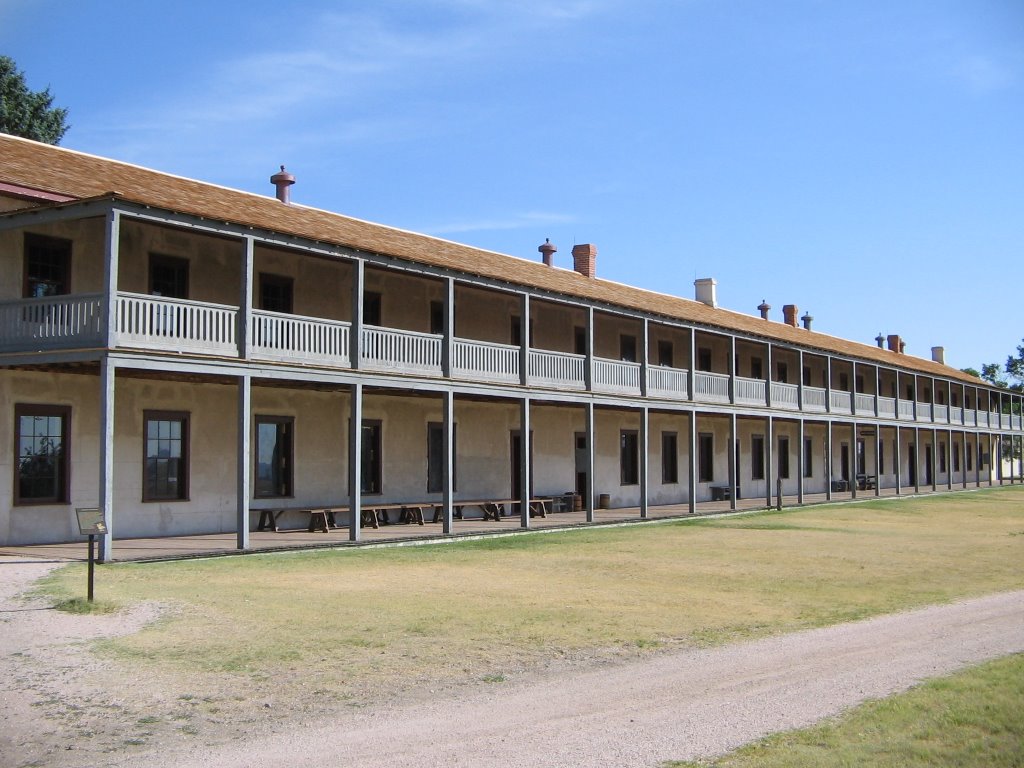
Continuing on past Ash Hollow one drives by Chimney Rock and Scotts Bluff. Here there are museums dedicated to the Oregon Trail. Indians get passing mentions like a brief sign which tells how the Sioux called Chimney Rock “Elk’s Penis.” Army representations are light. A few paintings at Scotts Bluff show cavalry but nothing major.
In Nebraska near the Wyoming border is a mere roadside dedicated to the Great Smoke. The Great Smoke was a meeting of 12,000 Indians where the United States government negotiated peace in 1851. The various nations attending had to be separated in order to keep the peace. The only person allowed to travel freely at the meeting was Father DeSmet. The peace was short lived. However, the treaty allowed Oregon and California to be settled by hundreds of thousands of emigrants. With both coasts settled, it was only a matter of time until the once useless Great American Desert would be conquered by the United States.
The last stop in the Great Plains section of the Oregon Trail is Fort Laramie. Here the Platte River valley ends and one sees Laramie Peak off in the distance. The peak acts as a welcoming sign to mountainous lands. Army life is well documented at the fort. Many buildings have had their interiors restored and this provides a window into the past. Informational signs in rooms tell of the day-to-day life of officers and enlisted men.
The history of Fort Laramie began in 1834. Fur trader William Sublette established of his trading post which he named Fort William. Sublette sent emissaries to contact local Sioux and Cheyenne to establish trade relations. The American Fur Trading Company bought the fort in 1836 and enjoyed excellent trading relations with the Sioux and Cheyenne. Trade was so prosperous that a rival company opened a trading post a mere mile away from Fort William. The American Fur Company sold the fort to the United States Military in 1849 as part of a militarization of the Oregon Trail and the fort was renamed Fort Laramie. The fort played a critical role in American Western operations until its closing in 1890.
Indian and emigrant relations were good for the most part during the time frame of the Oregon Trail. The fort was a resting and trading spot for Dakota Sioux Indians. Whole villages would come to the fort to interact with traders, government officials, and emigrants. It is estimated that in 1846 1,200 Sioux camped at once near Fort Laramie. Indians respected the power and authority of the army post. Dakota Indians sometimes performed funeral rites in sight of the fort in hopes the army’s presence would keep violators away. Cultural exchanges also took place at Fort Laramie. Pioneer Joseph Aram wrote in his 1846 trial diary how Indians preformed several songs and dances as exchange for some goods. Although these encounters did not alter the overall historic course of the Oregon Trail, they greatly affected the emigrants and Indians. These experiences, no matter how brief, humanized each side and allowed for greater understanding between emigrants and Indians.
Unfortunately a great tragedy occurred in Fort Laramie’s past. On August 17, 1854, a lame cow took off from a Mormon expedition and wondered into a Brule Sioux camp. The Mormon owner was too afraid to enter the camp and instead headed off to Fort Laramie to ask for military assistance from Second Lieutenant John Grattan. Grattan assembled a group of thirty-one men including him and entered in the camp demanding the cow and an alleged thief Grattan blamed for stealing the cow. The United States-appointed chief of the camp, Conquering Bear, negotiated for forty-five minutes until an impatient Grattan ordered his men to open fire with a cannon and guns. Conquering Bear was quickly killed. Brule and allied Oglala Sioux counterattacked and killed all but one of the infantry soldiers. The sole army survivor died days later. The misunderstandings and rashness on the parts of the Mormon emigrant and second Lieutenant Grattan forever poisoned United States/Sioux relations. Embittered Brule conducted raids during the winter of 1854 and the public outcry led to Colonel William S. Harney being assigned to avenge the Grattan Massacre. In 1855, Harney would get his revenge at the Battle of Ash Hollow.
Just as the historical archives record more tragedy then positives, so does the landscape. The Grattan Massacre site is marked by the Grattan Massacre Historical Monument. The 1953-erected monument contains a graphic of Indians killing soldiers as one officer bravely tries to fight troops which reminds one of the famous painting of Custer’s Last Stand. Another monument to Grattan’s troops is located along driveway to the fort’s parking lot.
“No One is Home” monuments are also common. The majority of signs at the fort are dedicated to the army. Some places have markers discussing the overland trails. Other monuments are dedicated to army wives and teamsters. One information sign, Fort Laramie and the Western Movement, prides Fort Laramie as being an “outpost of civilization.” The information center museum has displays about the history of the American west from pre-history to modern day. The last historical mentioning of Indians is the Wounded Knee Massacre. It is as if the Indians ceased to be after the massacre. Fort Laramie is a place lacking Indian history on the landscape. Not one Indian campground is marked while a hotel for stagecoach drivers, emigrant campgrounds, and trail ruts are. The gravesite of Mini-Aku, a Sioux who loved American culture so much she desired to have a funeral insight of Fort Laramie, is not memorialized in any way.
Thus ends the study area of the Great Plains of the Oregon Trail. It was a long journey and one Catholicgauze is glad to have done.

No comments:
Post a Comment